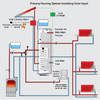Would it be better that I just stick to using the gas boiler to heat water?
I was rather surprised at results with an oil boiler, unlike modern gas, the oil boiler is on or off, so time running = kWh output. So summer would use oil boiler 4 times a week, at ½ hour each time, but would only run approx 20 minutes, water warm enough to wash hands but not as hot as it gets in winter. On fitting solar I used the iboost+ which shows how much used, so could compare, oil approx 25 kWh per week, electric 2.5 kWh per week, so even with electric being 5 times the price, still cheaper for me with electric, this of course with my house, with tank two floors above the boiler, so will vary house to house.
Why do you think you would need a tank with 2 immersion heaters?
The iboost+ heats the top immersion first, and only once that is hot does it switch to lower immersion heater, so two immersion heaters allows a fast re-heat time, but still stores a lot of energy in the water for cloudy days.
Traditionally we would have the two immersion heaters labelled sink and bath, with a switch on the immersion heater, this was before we lagged the hot water tank like we do today, and we used the heat from the tank to air clothes.
Latter we split the heating with bottom element on off-peak set slightly higher temp to upper element which was connected to peak, so the peak element would only switch on when running out of hot water.
The other method is to fit the immersion outside the tank, with the Willis system, this results in the tank being heated from the top down, theroy wise by far the best system, however unless you live in Ireland, finding a plumber who knows how to set them up, may be a problem?
This is a question for
@Madrab is it likely a mainland plumber knows how to install the Willis system? I am sure
@Madrab does, I feel from his posts he is a very knowledgeable man, but what about the run of the mill plumber?
My daughter in her Turkish home has solar panel DHW heating, which works well, but my father-in-law had it fitted in North Wales, and it looked the part, but about as much use as a chocolate fire guard. Maybe North Wales just did not get enough sun? However think more likely the installer had no idea of how to set it all up, plus the guy we got to repair it. Plumbers in UK don't fit many solar water heaters, so don't know how to do it.
Same today with heat pumps, I worked on heat pumps in 1980 in Algeria, and also in Hong Kong latter on, but very few in UK, OK Next in Chester had 9 units on the roof, but that was an odd one out, and the whole idea of heat pump was to cool the building not to heat, and the most important thing was all pipes need to be lagged, and one needs pumps and drains for the condensate, which are not needed for heat only systems, I have seen installations where to lagging is completely inadequate. Clearly the person fitting it had no idea of what was required. The Next in Chester had a ceiling collapse due to condensate on the suspended ceiling, caused because a clip was missing on the pipe to condensate pump.
So I tend to stick to electrics, and let the plumbers do their job, even if considered as allied trades.


